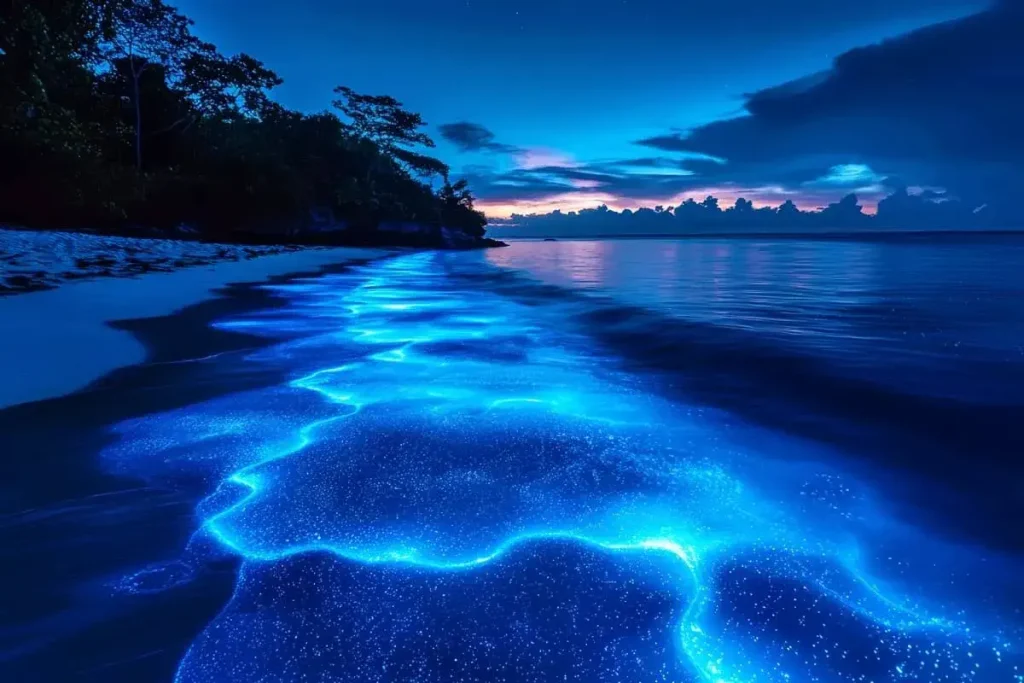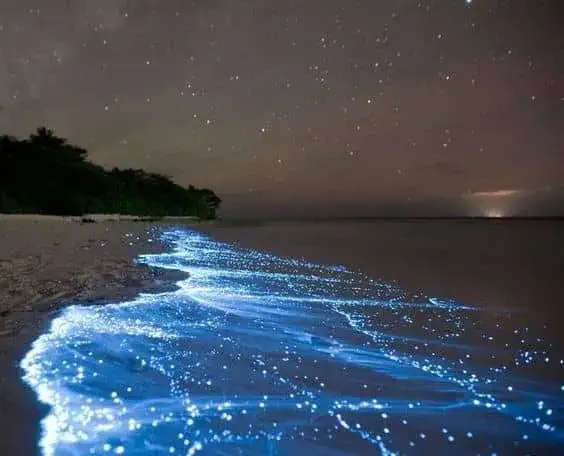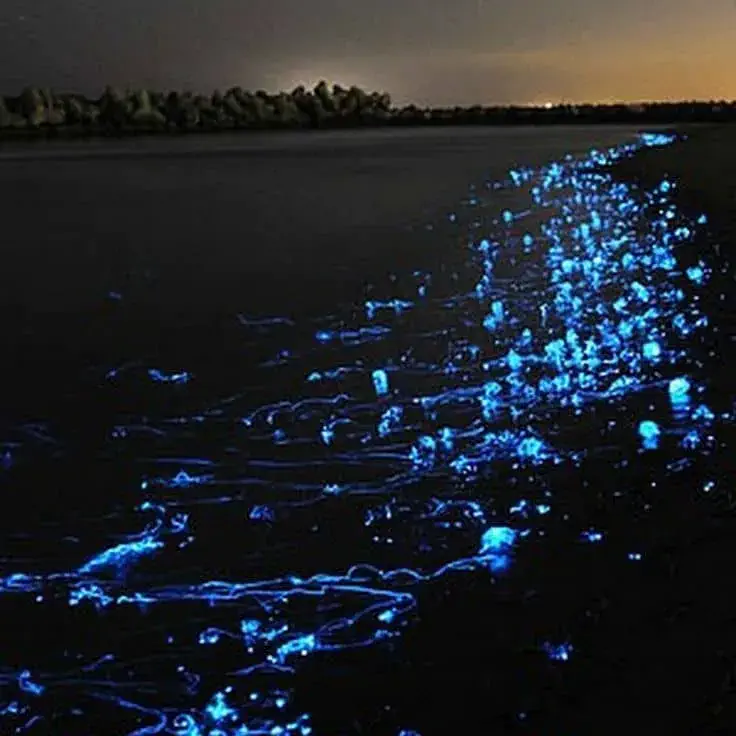
Imagine walking along a moonlit shoreline when suddenly, each step ignites a burst of electric-blue light in the waves. The ocean glows like a starry sky beneath your feet, and the water sparkles with every ripple. This isn’t science fiction—it’s the magic of bioluminescent beaches, one of Earth’s most enchanting natural phenomena. From the shores of Puerto Rico to the Maldives, these glowing coastlines captivate travelers and scientists alike, offering a glimpse into a world where biology and beauty collide. Let’s dive into the science, splendor, and secrets of these luminous wonders.
Table of Contents
The Science Behind the Glow: How Bioluminescence Works
Bioluminescence is a chemical reaction that allows living organisms to produce light. It occurs when luciferin (a light-emitting molecule) reacts with oxygen, aided by the enzyme luciferase. This process, often called “cold light,” generates almost no heat, making it incredibly energy-efficient.
Why Do Organisms Glow?
- Predator Evasion: Tiny marine creatures like dinoflagellates (the most common bioluminescent plankton) flash to startle predators.
- Attracting Prey: Deep-sea anglerfish use glowing lures to entice meals.
- Communication: Some species, like firefly squid, light up to coordinate mating rituals.
Dinoflagellates, such as Pyrodinium bahamense, are responsible for the shimmering waves at many beaches. When disturbed by waves or movement, they emit a blue-green glow, transforming the sea into a living light show.
Where to Witness the Phenomenon: Top Bioluminescent Destinations



While bioluminescence occurs globally, certain locations offer consistent, breathtaking displays:
- Mosquito Bay, Vieques (Puerto Rico): Dubbed the “Brightest Bio Bay,” its high dinoflagellate density creates an intense glow.
- Maldives’ Mudhdhoo Island: Known for “sea of stars” beaches, where washed-up plankton sparkle in the sand.
- Toyama Bay, Japan: Firefly squid illuminate the waters from March to June, drawing photographers worldwide.
- San Diego, California: Seasonal red tides (caused by Lingulodinium polyedra) create neon-blue waves.
- Jervis Bay, Australia: Home to glowing phytoplankton that light up the white sands.
Lesser-Known Gems:
- Halong Bay (Vietnam)
- Manasquan Beach (New Jersey)
- Matsu Islands (Taiwan)
Ecological Importance and Conservation Challenges
Bioluminescent organisms are more than just a visual marvel—they’re vital to marine ecosystems. Dinoflagellates contribute to nutrient cycling and serve as food for small fish. However, these fragile ecosystems face threats:
- Pollution: Runoff from agriculture and plastics disrupts plankton populations.
- Climate Change: Warmer waters and ocean acidification alter habitats.
- Light Pollution: Artificial lights from coastal development diminish visibility of natural bioluminescence.
- Tourism Impact: Overcrowding and careless swimmers harm delicate ecosystems.
Conservation Efforts:
- Puerto Rico’s Mosquito Bay was restored after Hurricane Maria through strict anti-pollution laws.
- The Maldives enforce “no-touch” policies to protect plankton.
- Organizations like Ocean Conservancy and UNESCO advocate for protected marine areas.
Historical and Cultural Significance: From Folklore to Modern Science
Bioluminescence has fascinated humans for millennia:
- Ancient Mariners: Early sailors documented glowing seas in logs, often attributing the lights to gods or omens.
- Aristotle’s Observations: The Greek philosopher described bioluminescent fungi in 382 BC.
- Indigenous Myths: Caribbean tribes believed the glow was the spirits of ancestors guiding fishermen.
Today, bioluminescence inspires art, films (Avatar, Life of Pi), and medical research. Scientists study luciferase for cancer detection and neurological disease tracking.
Experiencing Bioluminescent Beaches Responsibly
To preserve these wonders, follow sustainable tourism practices:
- Visit During New Moons: Darkness enhances visibility, reducing the need for artificial lights.
- Avoid Chemicals: Skip sunscreen/oil before swimming; they harm plankton.
- Choose Eco-Tours: Licensed guides use kayaks instead of motorboats to minimize disturbance.
- Photography Tips: Use a tripod, manual focus, and long exposure (15-30 seconds).
Advantages and Disadvantages of Bioluminescent Beaches
Advantages of Bioluminescent Beaches
1. Boosts Tourism and Local Economies
- Economic Growth: Bioluminescent bays attract thousands of visitors annually, generating revenue for local communities. For example, Puerto Rico’s Mosquito Bay contributes over $5 million yearly to Vieques’ economy through guided tours and hospitality.
- Job Creation: Eco-tourism supports jobs in guiding, hospitality, and conservation. In the Maldives, resorts near bioluminescent beaches employ locals for night tours and environmental education programs.
Example:
- San Diego, California: Seasonal bioluminescent waves during red tides draw photographers and tourists, boosting off-season tourism.
2. Educational and Scientific Value
- Research Opportunities: Bioluminescent organisms are studied for medical breakthroughs. The enzyme luciferase is used in cancer research to track cell activity.
- Environmental Education: Bio bays serve as living classrooms. Schools in Puerto Rico organize field trips to Mosquito Bay to teach students about marine ecosystems.
Example:
- Toyama Bay, Japan: The annual firefly squid migration provides data on climate change’s impact on marine behavior.
3. Ecological Benefits
- Nutrient Cycling: Dinoflagellates contribute to oceanic food webs and carbon cycling.
- Indicator Species: Bioluminescent plankton populations reflect water quality. A decline often signals pollution or ecosystem imbalance.
Example:
- Jervis Bay, Australia: Monitoring glowing phytoplankton helps scientists assess nutrient runoff from nearby farms.
4. Cultural and Aesthetic Appeal
- Inspires Art and Culture: The phenomenon influences local folklore, music, and art. In the Maldives, bioluminescence is celebrated in traditional dances.
- Unique Experiences: Few natural wonders rival the magic of swimming in glowing waters, creating lifelong memories.
Example:
- Halong Bay, Vietnam: Night kayak tours blend bioluminescence with cultural storytelling about ancient seafarers.
5. Low Environmental Footprint (When Managed Responsibly)
- Sustainable Tourism: Kayak tours (e.g., in Mosquito Bay) minimize pollution compared to motorboats.
- Renewable Attraction: Unlike artificial light shows, bioluminescence is a self-sustaining natural event.
Example:
- Matsua Islands, Taiwan: Strict visitor caps and paddle-only tours preserve the bay’s glow.
Disadvantages of Bioluminescent Beaches
1. Environmental Vulnerability
- Sensitivity to Pollution: Chemical runoff from agriculture or sunscreen can devastate dinoflagellate populations. Jamaica’s Luminous Lagoon has dimmed due to industrial waste.
- Climate Threats: Rising sea temperatures disrupt plankton blooms. In 2020, a heatwave reduced bioluminescence in Thailand’s beaches by 40%.
Example:
- Puerto Rico’s Recovery: After Hurricane Maria (2017), Mosquito Bay required a 2-year restoration to revive its glow.
2. Seasonal and Unpredictable Displays
- Inconsistent Timing: Bioluminescence depends on plankton blooms, which vary yearly. Tourists may travel long distances only to miss the spectacle.
- Weather Dependency: Heavy rain or bright moonlight can obscure the glow.
Example:
- San Diego’s Red Tides: While stunning, these events are sporadic, occurring only 1–2 times per decade.
3. Ethical Concerns About Tourism
- Overcrowding: Unregulated tours stress ecosystems. Thailand’s Koh Rong Island saw a 70% drop in bioluminescence after a tourism surge in the 2010s.
- Physical Damage: Swimmers or boats can crush organisms. In the Maldives, reef-safe sunscreen is now mandatory to reduce harm.
Example:
- Puerto Rico’s Regulations: Swimming was banned in Mosquito Bay after tourists disrupted sediment layers, smothering plankton.
4. Safety Risks
- Harmful Algae Blooms (HABs): Some bioluminescent organisms, like Lingulodinium polyedra, produce toxins during red tides. Contact can cause skin irritation or respiratory issues.
- Navigational Hazards: Night tours risk accidents in dark, unfamiliar waters.
Example:
- Florida’s Gulf Coast: Red tides in 2018 caused health warnings alongside bioluminescent waves.
5. High Conservation Costs
- Expensive Protection Measures: Restoring bays requires funding for water testing, pollution control, and community education.
- Balancing Access and Preservation: Limiting visitor numbers can spark conflicts with businesses reliant on tourism.
Example:
- Maldives’ Conservation Fund: Resorts charge a $10 nightly fee per guest to fund plankton protection initiatives.
Conclusion: Protecting Nature’s Living Light Show
Bioluminescent beaches remind us of the ocean’s fragility and wonder. As climate and human pressures escalate, conservation becomes critical. By supporting eco-friendly tourism and reducing plastic use, we can ensure future generations witness these glowing shores. Whether you’re planning a trip to Puerto Rico or simply marveling at photos, let the magic of bioluminescence inspire a deeper connection to our planet’s mysteries.
FAQs
Is it safe to swim in bioluminescent water?
Yes, but follow local guidelines. Some areas, like Mosquito Bay, prohibit swimming to protect plankton. In approved zones, avoid sunscreen and sudden movements to prevent stressing organisms.
When is the best time to see bioluminescence?
Summer and warm months are ideal, but timing varies. Avoid full moons—darkness amplifies the glow. Check local tide charts for plankton blooms.
Can bioluminescence occur in freshwater?
Rarely. Most bioluminescent organisms are marine. Exceptions include New Zealand’s Waitomo Caves, where glowworms illuminate freshwater streams
Why do some beaches glow brighter than others?
Density of organisms, water temperature, and pollution levels affect intensity. Mosquito Bay’s enclosed shape concentrates dinoflagellates, creating a vivid display.
5. Are bioluminescent bays disappearing?
Yes. Pollution and climate change threaten many bays. For instance, Jamaica’s Luminous Lagoon has dimmed due to industrial runoff. Conservation is key to survival.
Explore Further:
